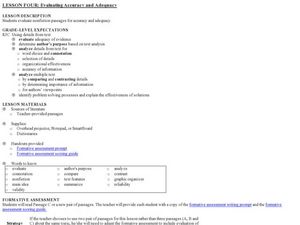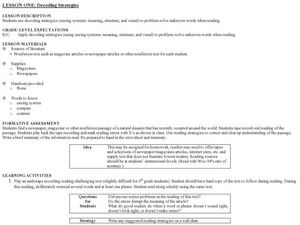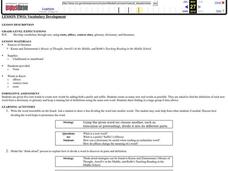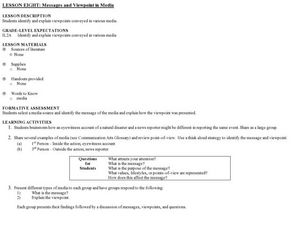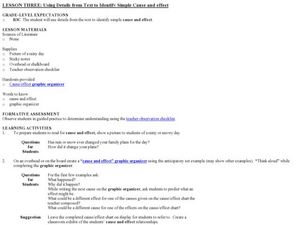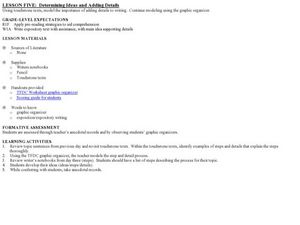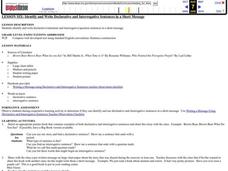Curated OER
Brochure Writing
What do you use a brochure for? Middle schoolers or underperforming high schoolers identify the attributes of informative brochures. Either bring in a few brochures you've collected or use the sample brochures attached here. While...
Curated OER
Using Pre-reading Strategies: Infer
Use this resource to support your class practicing inference with poetry and visual art. The plan calls for an examination of "The Scream" by Edvard Munch and the "Mona Lisa" to promote speculation about artist's intent. From there, it...
Curated OER
Irony in Poetry and Prose (Fiction and Non-fiction Texts)
Middle and high schoolers examine the impact of irony in poetry and prose. In this figurative language lesson plan, they read instructor-selected literature and identify uses of irony. Then they discuss how irony enhances literature.
Curated OER
Identify Text Features in Nonfiction
What does a non-fiction text look like? Examine the text features of non-fiction. Middle and high schoolers read non-fiction passages provided by their instructor and analyze the texts for word choice, details, and organization.
Curated OER
Evaluating Accuracy and Adequacy
Evaluate non-fiction works with your English class. While practicing a variety of strategies detailed in the plan, readers compare and contrast the information in three non-fiction passages about the same topic. They then discuss the...
Curated OER
Lesson One: Decoding Strategies
Review decoding strategies to read a chosen text. Readers tape themselves reading out loud, listen to the recording, and mark where they have misread words or phrases. They then discuss which words were misread and review how to correct...
Curated OER
Vocabulary Development
What is a root word? What is a prefix? Suffix? Use these questions to spark a discussion amongst your language art learners. Then, start by writing the word irresistible on the board and have teams of learners attempt to create new words...
Curated OER
Messages and Viewpoint in Media
Explore media point of view. In this literacy and current events lesson, pupils identify examples of first and third person point of view in media articles. They analyze examples of media, interpret the messages, and determine purposes...
Curated OER
Table Manners: Ready, Set
Help kids understand the importance of proper table manners through listening to the poem Table Manners and discussing formal etiquette. Afterward, the class can practice good table manners in a classroom feast!
Curated OER
Using Details from Text to Identify Author's Purpose
Explore writing techniques by analyzing newspapers and magazines with middle schoolers. They will collaborate in small groups to read local news stories and identify the main ideas and author's intent. They also utilize an information...
Curated OER
Using Details from Nonfiction Text to Organize Sequence of Events
Is it important to do things in a certain order? Yes, especially when making a peanut butter and jelly sandwich. Or so your class will learn in a lesson on sequencing. After guided practice, class members generate their own “how-to”...
Curated OER
Lesson Three: Using Details from Text to Identify Simple Cause and Effect
Third graders identify cause and effect. In this cause and effect lesson, 3rd graders use a graphic organizer to predict effects for certain causes. They read a non-fiction text and put sticky notes marking causes and effects.
Curated OER
Compare and Contrast Nonfiction Texts
Explore nonfiction writing by comparing and contrasting two different texts. After reading two nonfiction books, articles, or magazines, students utilize a graphic organizer to record their similarities and differences. They answer study...
Curated OER
Use Details from Text to Identify Cause and Effect, Draw Conclusions, Compare and Contrast
Third graders discuss research topics and write a paragraph on one of the provided questions. They focus on including key words from charts that the class has been compiling. They underline supporting details within the text they write....
Curated OER
Text Features of a Story
Bring the enjoyable story of Anansi and the Moss-Covered Rock by Eric A. Kimmel to your young readers. After reading the story as a class, students answer questions about a reading and make a graphic organizer. They make...
Curated OER
Community Ripple
Originally designed to be used along with a text that is not included, this plan contains a graphic organizer and word guessing game to help readers use decoding strategies to gain new vocabulary. A set of questions relating to community...
Curated OER
Determining Ideas and Adding Details
A handy TFDC (topic/fact/detail/conclusion) graphic organizer (included) allows young writers to outline and record their main ideas and supporting details in the prewriting phase. They then continue to add details to the topic sentences...
Curated OER
Declarative and Interrogative Sentences
Learners write interrogative and declarative sentences in a short message. After seeing many examples of these types of sentences, students write sentences of their ownl.
Curated OER
Capitalization and Punctuation
First and second graders explore writing conventions. They add question marks or periods to the end of teacher generated sentences on sentence strips. They locate punctuation marks in poems and write original sentences using appropriate...
Curated OER
Spelling, Capitalization, and Punctuation
Elementary schoolers explore writing conventions. First they play a ball toss game to practice spelling high frequency words. (A link to a 2nd grade list is attached.) The class works together to correct spelling, punctuation, and...
Curated OER
Making More Words With "at"
Learners explore phonetics by identifying words with one specific sound. In this rhyming words lesson, students discuss the sound "at" and the many words that contain the same sound. Learners utilize index cards to participate in a word...
Curated OER
Annie and the Wild Animals
Here is a reading comprehension instructional activity in which learners predict the story plot of Annie and the Wild Animals, by Jan Brett, after viewing the cover. They listen to the story, and answer story structure questions...
Curated OER
Perseverance: Keep Going
Kids evaluate world history events that show perseverance by creating artistic images. They investigate historic photographs and images which conjure up the feelings of perseverance, then utilize acrylic paints to capture the...
Curated OER
Animal Keynote Report
Learners produce a research project on an animal. Using the Internet, they find pictures and information about animals. They are also given a list of items that should be covered in their report, including the appearance of the animals,...




